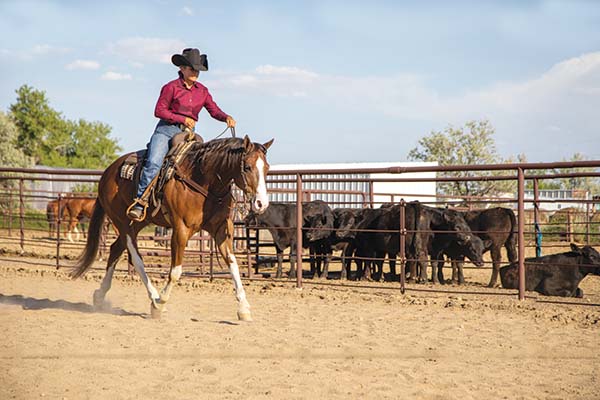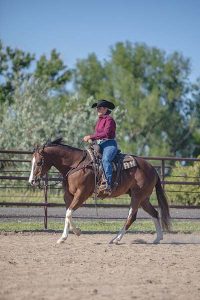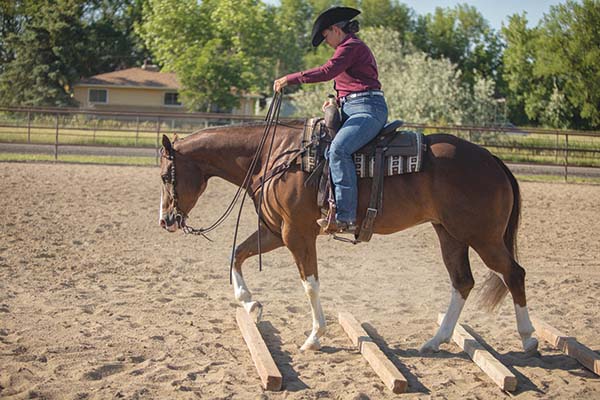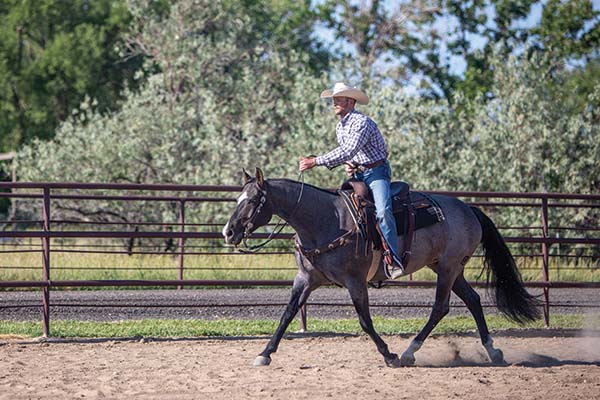Ranch riding tops the list as one of the most popular western show classes. The appeal? A class that riders can succeed in without expensive silver-adorned saddles or fancy clothes. Most any horse-and-rider team that prepares for the pattern class has a chance to win.

Horses walk, jog, lope, trot with extension, lope with extension, stop, back, and change directions. The 15 AQHA patterns also include sidepassing, 360-degree turns, lead changes (simple or flying), poles, and other “reasonable maneuvers that a ranch horse could perform.” The latter may include light cattle work.
Julian Nemmers is a champion-earning trainer and regular competitor in ranch riding. Along with his wife, Nancy, and son, Justin, the family has earned ranch-riding honors at the AQHA World Championship Show, as well as at top Appaloosa Horse Club shows. The Nemmers’ ranch is in Longmont, Colo. Their clients have also received World Champion titles and national-level honors.
Here, the Nemmers discuss why the class is so popular and share tips to help you succeed.
Fair Game
“This is the class that’s made for the horse we all want to ride: an easy-going animal that’s smooth to ride and is consistent,” Julian says. “Many of the horses that do well in the class also show in other classes, but it’s available to all types of horses. A rider can go in with a limited amount of investment and do well.”

Julian says that horses trained for cow work and reining easily transition to ranch riding. However, those horses may need to learn to extend the trot and work over poles. They’ll also need to stop without sliding.
A horse that has done real ranch work may have the desired ground-covering gaits but may not have fast turnarounds. The winner for the show may depend on the maneuvers required that day.
“A great horse can be beaten by a mediocre horse if the great horse breaks gait,” says Julian. “There are so many maneuvers in each pattern that you can beat an exceptional horse if you do well at every maneuver and show off what your horse is best at.”
The Ranch Riding Look
You and your horse should present a clean look—ready for real ranch work. For your horse, this means no bands, no hoof paint, and little to no clipping. The Nemmers trim bridle paths and sometimes show a horse that is clipped for other events.
Choose a saddle that you ride in for work without excess silver. Riders compete in a button-down shirt, jeans and a hat.
Ride the Ranch Way
Judges want to see horses ridden with contact. Forget the usual show-ring posture and long, draped reins. For this class, you’ll ride like you are getting a job done.
“All horses should be soft in the bridle,” Julian says. “While we strive for a horse that is level-headed, some horses may be naturally higher headed, and that’s OK.”
It’s permissible to post or stand for an extended trot and to stand for the extended canter. Allow your horse to move forward.
He should also be comfortable riding near or through cattle. There may be cattle penned beside the show pen. Make sure you can ride straight past without your horse turning to look or becoming worried.

“An all-around horse may not be used to seeing cattle,” Julian says. “Keep in mind that what you look at, your horse will, too. Your eyes turn your body, which turns your hips. Get your horse used to the cattle at home or during warmup, then walk on by. Sometimes you’ll be asked to open a gate and ride through the cattle, move them around, and come back to the gate and exit.”
Ranch Riding Success
Each pattern has a different number of maneuvers, so the score can vary. For each maneuver, you can get a positive or negative mark. Make sure you’re showing at every moment.
“You almost always enter the arena at a walk,” says Julian. “The extended walk carries as much weight in the points as an extended trot. If you come in the arena and ask your horse to cover ground with an alert look, you’ll do much better than if your horse looks half asleep.”
He recommends following the pattern exactly. Ride to the correct mark and make your transitions obvious.

“The speed of your gait should be equal from the start to finish—matching when the pattern asks for that change,” Julian continues. “You don’t want to slowly build up to the requested gait. Be precise and follow the pattern.”
The Nemmers agree that downward transitions can make or break your show scores. Downward transitions from the extended lope to the extended trot rob riders of points.
Practice at home and make sure your horse knows a precise cue for that transition. Julian says that standing up on the transition may help you give your horse a clearer cue.
If you know your horse’s strengths, practice your transitions at home, and memorize your pattern, you may have a new favorite show class.
Western Training<<
Changing Riding Disciplines<<
Thanks to Julian, Justin, and Nancy Nemmers for modeling on Shining Sail, Sippin on Champagne, and Boxo Heavens Firefly.
Watch a PatternClick to watch as Julian Nemmers guides you through AQHA Ranch Riding Pattern 1. |






